Since then, I had another yearning; to trace the family roots which I had not done in the first trip. My uncle Poh Thiam who had not been there before had asked me if I could organise another trip 2 years ago. My other siblings were also keen to make the trip. And so, after talking about it for more than a year, I managed to get things organised. I had booked the MAS ticket from 26.6.12 to 30.6.12 for my parents, Uncle Poh Thiam and wife Yek Lian, and Uncle Tan Choon Chee, who is my fathers cousin. My brother KC and sister Lilian would join us from the states. Another brother Stephen who is working in China but took time off for a week in NZ would fly in from there to join us.
DAY 1 : 26.6.12 ( Tuesday )
My parents on the 6.30 am train to KLIA.
Met up with Choon Chee ( above ), Poh Thiam and Yek Lian at KLIA.
Upon arrival, KC and Lilian was at the Xiamen airport waiting for our arrival at 1.45 pm. Stephen ( not in the picture ) was there too. Below is the van we had chartered for the enitire trip.
The overseas siblings were in Xiamen a day earlier. Those from Malaysia flew into Xiamen on 26.6.12 and together, we hit the road from Xiamen airport at about 2.30pm. I had remembered we ate at an isolated shop somewhere in Tong An that served tasty pork during my first trip. I just have to visit that shop again even though it resembles "long men ke chan"! Everyone burst out laughing when they saw the shop.
Everything is the same as 6 years ago.
What's that dish that I so rave about. You cannot tell the taste by the picture. This is country cooking. They called it Tong An pork, and it's well known to those who come to Xiamen or Yong Chun.

As I enter Yong Chun, I could barely believe this was the place I had visited in 2006. It does not have that county look that I saw before, but is now all modern, city like, well landscaped with night lightings all over.
I had arranged for Tan Lian Choon to meet us at Tao Yuan Hotel in the evening. We met him in our earlier trip as he knows my Grandfather and is from the same village in Hong San.
We also arranged for the house caretaker family, Tan Poh King and his son Tan Eng Hian to meet us at the hotel . Both are already the 3rd and 4th generation from the original caretaker. I had met Eng Hian in my first trip.
We proceeded to have dinner at the Tao Yuan Reastaurant and talked a bit about Yong Chun.
After dinner, Uncle Choon Chee was eager to meet up with his cousin Kuang Qian whom he had never met.
Together with Kuang Qian's brother, Chong Ming and their families, they had a great time catching up.
A while later, more relatives came out to meet up with Uncle Choon Chee. It was a wonderful reunion for all of them. They really had a lot of catching up to do.
All this take's place outside the modest shop of Ah Tee, our travel agent. He has been instrumental in locating and arranging this reunion for Uncle Choon Chee. The picture below is the street opposite the shop.
It had been an eventful first day. Much have been achieved. Choon Chee had only the name of his cousin and the village and we never expect to be able to locate them and meeting them on the very first day. Eng Hian had also told us over dinner that he had a copy of the Zupu for the Tan family staying in Hong San. That book is all important for us to be able to trace our family tree upwards. I was confident that my great grandfather's name would be in the Zupu. For centuries, China have a practice of keeping written records of clans, families, generation by generation. That is the fantastic part of chinese culture, every family has a detailed family tree written into a book called Jiapu and Clans record called Zupu. Eng Hian will let us go through his Zupu tomorrow.
Day 2 : 27.6.12 ( Wednesday )
I worked up early the next morning and decided to take a morning walk out of the town centre. I wanted to see the less developed part of Yong Chun.
Upon walking back, I could see a block of shoplots, vacated, for remodeling.
This is how it would look after remodeling. They just do up a nice facade but the interior is the same. I was told by the locals later, all that I saw in the town centre was done only in the last two years. It's amazing how they can transform a whole town in just two years! Buildings remodelled, street landscaped, ornamental lightings to beautify the town at night, with streets being swept daily. This can only happen in China !
Another development on the way up. Believe me, it will be up and running in two years time !
As I got back to the town centre, most shops are still closed. But my eyes caught sight of all the shop names which is not what we see normally back home.
During this time, the rest of the family members were nicely having their breakfast along the food street opposite the hotel. Guess what is Lilian and dad eating?
Yes, Yau Char Kwai and groundnut soup. Typical peasant food that we used to have in our younger days.
The street is busy each morning as it is at an open market area.
Poh Thiam and Lilian cannot resist the local produce, cheap and good.
After breakfast, we proceeded to Hong San village in our van.
We had arranged for Tan Lian Choon to meet us at the Loyang community building. He knows where the house is as he is the one who showed us the house during my last trip. I did not have a map of this village and therefore it's easier to have him guide us there.

In no time, we were walking along the road passing through houses built haphazardly as in all villages.
Eager beaver Lilian moving off fast leaving mum struggling behind her.
Lian Choon leading the way.
Choon Chee trudging along the padi field.
Stephen just need to have a picture taken for memory. The house is at the background.
As we near the house, we had to use the footpath along the padi field which is slippery.
It is really easy to slip and fall here if not careful.
ENG CHIN TONG.
The house that grandgather left as a teenager and never return to.
In his Jiapu, GF had the rudimentary description of the location as follows:
House Name : Eng Chin Tong, Village : Pang Sua Tao, ( Hong San Village )
Location : Ber Sua ( last hill ), Sitting Direction North East, Facing Direction : South West.
I had used the facebook "Check In" for the exact location in the GPS and the cordinate reading is
25.328865, 118.322972.

Above, my father and brothers, Stephen and KC and below, Lilian inside Eng Chin Tong. It had been left vacant since 1919, almost a 100 years by now and is in a delapidated condition.
In his Jiapu, GF had the rudimentary description of the location as follows:
House Name : Eng Chin Tong, Village : Pang Sua Tao, ( Hong San Village )
Location : Ber Sua ( last hill ), Sitting Direction North East, Facing Direction : South West.
I had used the facebook "Check In" for the exact location in the GPS and the cordinate reading is
25.328865, 118.322972.

Above, my father and brothers, Stephen and KC and below, Lilian inside Eng Chin Tong. It had been left vacant since 1919, almost a 100 years by now and is in a delapidated condition.
The house courtyard. All village house has about the same design. Main hall, left and right wing, coutyard and main door.
Stephen at the main door.
KC cheekily putting up a "To Let" sign !
Choon Chee and his cousins having a chat in front of the house, village style.
Poh Thiam having a chat with Poh Ting, the current caretaker, Poh King. Poh King is the grandson of the Geok Hau, the person GF entrusted the house to before he left.
Having a chat at the well at the front right of the house.
The right side of the house.
Overlooking the house are vast tracts of padi field and beyond are the newer houses built in the village.
At the back of the house is what seems to be the end of the rolling hills. This might have been referred to by GF in his Jiapu as "Ber Sua", which in hokkien means last hill or end of the hill.
Above, the house still looks majestic from the outside and it overlooks a flat plain of rice field. Below, is the older house located next door which is used as a store shed now by the caretaker.
One last look on the way out,
and we all start trudging back the way we came.
ANCESTRAL HOME OF THE TAN IN HONG SAN VILLAGE.
This is the house of the first Tan that came from Henan and settled in this village called Hong San.
It is today the ancestral hall for the Tan in this village. The majority of the villagers surname is Tan. Their family tree all link to Chong Kong which is the first Tan here. Therefore, all are related, including us.
Mum praying to the ancestors at the hall,
Poh Thiam and Winne at the courtyard of the ancestral hall.
This is the second ancestral building of the Tan. It is located about 200 metres away from the first one and is at the lower part of the terrain.
Above ( my father and I ) and below ( me and my siblings ).
Just next to this 2nd ancestral hall is a modern village house belonging to one of the village sinseh.
Lian Choon had arranged for us to meet at this house to trace our family lineage.
This is the all important Zupu of the Hong San Tan's heritage. Practically every family in Hong San village has a copy this Zupu, where every single family members are recorded, names, parents, children, date of bith etc
The public records was destroyed during the Cultural Revolution in 1956. Now there is conscious effort to reenact the records from privately owned collections to reproduce this great chinese heritage.
The elderly villager in this photo is the person that is reenacting the Zupu for Hong San village. He mentions the house that we went to as Tan Leong Tham's house ! Amazing, that is my GF and he would not know him as he would be too young when GF left this village. But then he knows every household in Hong San village.
He started tracking from the Zupu, the name of my Great GF, Chen Siu Min, and all the way up to Chong Kong, which is the first Tan in this village. That is 22 generations from me! Step aside Alex Haley, the Kunta Kinte that you've traced is a mere 8 generations.
There, that's Chen Siu Min, your Great Grand Father's name on records !
We spent more than an hour here tracing the family lineage.
Choon Chee is keen to trace his own lineage which also links with us.
KC must have a copy of the Zupu to satisfy his quest.
Even though GF is the progenitor for his family in Malaysia, the request is made for us to send in all our family jiapu records from Malaysia to update into this Tan's Zupu to be kept as a heritage in Hong San village. That we promised to do.
A group photograph is a good memory of the kind villagers who have helped us trace our family lineage and allowing us to replicate 3 copies of Zupu to back with.
Visiting Choon Chee's Cousins house.
My father had visited them during his first vist some 20 years ago. At that time, this was the house that they stayed, a traditional chinese village house.
Now they had built a modern house of three storey just behind the traditional house. This is reflective of better times and is generally the same throughout the whole of China.
Taking a peek, new house, but same habit, motor bike is kept in the house.
Master bedroom, traditonal bed is still used.
There is some difference in the kitchen, electric rice cooker , hot plate, hob nob all electric.
We were invited to have lunch in their house. And the meal is better than the restaurant food that we've eaten thus far! The lady of the house used to be a chef in a restaurant!
Stariways to heaven. No railings.
No prize for guessing who is the host !
Beers are served after lunch. It's not normal for them, but that's because they really welcome us as their guest.
Chatting over tea, that's the norm.
Choon Chee and my father having a photo with the gracious host.
I had to take the photos of the three cousins.
Can you tell which two are locals ?
We had to move after lunch with all our mission accomplished. We had visited GF's house, trace our family tree, Choon Chee had reunited with his cousins and generally, we had reconnected with the village people who shared the same ancestors with us.
On the way out, we stop by a printer whom we we were told had the plates for printing the Zupu of Hong San village. They did not have it but arranged to photostat 3 copies for us at RMB 240 per book. However, they can only have it ready the next day at 3.00pm. We agreed to pick it up tomorrow.
![]()
Visiting Dongguan Bridge.
When Gf was around, he used to say good woods would never reach Dongguan Bridge. We never really knew what he meant. Most people in Yong Chun had that same saying. It's an irony because Dongguan bridge here is made of wood that had lasted for centuries, about 800 years !
Me and my siblings at one end of Dongguan Bridge.
At the mid section of the bridge is a diety, The Goddess of Mercy.
Poh Thiam is very at home here with a local.
He just need to pay homage to the diety.
Lilian admiring the woodwork. Notice the locals at the background, they like to "lepak" here
Every section of the bridge, there will be drawings of chinese legends. It is just like the bridge at Lucerne lake, they had the same kind of drawings of western fables.
After that, we went to highest hill in Yong Chun to have a view of the county. Choon Chee couldn't resist having a photo in front of the pavilion.
The rest too love to have their photos taken.
My parents with their weary legs.
The view from the hill does show that Yong Chun is almost landlocked. It is actually very scenic, almost Swiss like.
We had another fulfilling day by the time we head back to our Hotel.
We had arranged for Choon Chee's cousins to have dinner in town with us.
Outside the hotel, are some sitting area around the young trees. That's where we had a chat with them for a while as it is cooling out there.
We adjourned for dinner at a restaurant just opposite the Hotel where we stayed.
We had a wonderful dinner together.
Just to be sure we stay in touch, we got their addresses down on a piece of paper.
After dinner, some of us went shopping for the popular "kau nah" ( bakul ). I went with my father for a stroll around town. Choon Chee had wanted to buy a pair of reading glass here.
The lighting for this small town is amazing. There was absolutely no lightings like these during my earlier trip 6 years ago. Then it was only street lights.
This time, as you can see from the pictures, ornamental lights transformes the town to a fairyland at night.
Soon we meet up the others at the same spot outside the hotel. It is nice and cool and the chat continues.
DAY 3 : 28.6.12 ( THURSDAY )
We all meet for breakfast the next morning at a shop behind the hotel. Not much choice in menu, but the mee suah soup is about the same as ours in Malaysia.
We had achieved what we came for in two days. It's time we do a little sightseeing. The original plan was to leave YongChun and stay in Quanzhou for a night. But the Zupu can only be ready by 3.00pm today. So we decided to do a day trip to Quanzhou and back to YongChun for one more night.
FENGSHAN SI, PHOENIX MOUNTAIN TEMPLE, SISHAN, NAN'AN.
About 20 minutes out of Yong Chun into Nan'an, we stop by Fengshan Si located at Sishan village. This temple had it's history traced back to the 10th century and is popular among the locals and the overseas Hokkien. Early chinese migrants, especially those who migrated to South East Asia like my GF, brings with them popular local deities of the regions where they migrated from. The deity worshipped at this temple is Guangze Zunwang which was traced to one Guo Zongfu. Guo Zongfu was born to a poor family who sold himself as a slave when his father died. His filial piety and ability to do miraculous deed formed an important discourse of his deification upon his death/ascension at a young age of 16. The villagers built this temple here at Sishan, Nan'an in honor of him and called this mountain Fengshan Si, or Phoenix Mountain Temple. It has since undergone various upgrading to what it is today.
Poh Thiam have to have his fortune read by a fortune teller at the temple. Lilian just have to listen to it.
KC at the temple corridor.
QINGJING MOSQUE, TUMEN STREET, QUANZHOU.
QINGJING MOSQUE, TUMEN STREET, QUANZHOU.
This mosque is the oldest arab stye mosque in China. It was built in 1009 by the Arab muslims during the early cultural exchange between China and Arabic countries. Part of it's structure had been destroyed in an earthquake.

Tablets insciption that traced the religion back to the Song Dynasty where Arab traders came via the marine silk route. Some had settled in this busy city of Quanzhou and married the locals.


New mosque bult at the same compound.
KC inside the entrance of the mosque.
KAI YUAN TEMPLE.
This temple is reputed to be the largest temple in Fujian Province. It was built during the Tang Dynasty period ( 618 - 907 ) by Emperor Xuanzong. This temple attracts many pilgrims and is a divine place where Buddhists cultivate themselves according to the Buddhist doctrines with great concentration.
Tortoise is KC's favourite.
One of the two pagodas inside the temple compound.
Taking a respite from the heat.
A street scene in Quanzhou.
Poh Thiam and Lilian bargaining with a fruit vendor.
Dad inside a shopping mall where Walmart is located.
Poh Thiam in a deep conversation with dad at a restaurant inside the mall.
A penny for your thoughts, mum. What is she thinking about?
Choon Chee and I ordering food for lunch. We ended up ordering almost the same food every day.
After lunch, we headed back to Hong San Village in Yong Chun to pick up our Zupu and the photostated copies from the printing shop. We have to return the copy that was loaned to us for duplication.
The driver did not know Eng Hian's house in the village. Eng Hian is at work in the farm. His wife met us at the agreed spot within walking distance from her house.
We met in front of the community building of the Hong San village and return their copy of the Zupu there.
The community building keeps the records of Zupus, history and everything relating to this village.
One last look at the country road ( above ) before we head back to Yong Chun town ( below )
In the evening, we had our own dinner and decided to do some last minute shopping. Knowing that we are leaving the next day, Eng Hian and his wife came by the hotel to meet us to say goodbye. It was unexpected but they were warm simple folks that treasure our visit. We promised to stay in touch.
Day 4: 29.6.12 ( Friday )
This being the day we dapart Yong Chun, I decided to photograph as many street scene and building as possible. I would like to preseve some memories of places that I had visited and seen during that particular period. It had took me by surprise that if Yong Chun can changed so much in two years, in the next ten years, this place may be a city developed beyond recognition.
Compare this building with the earlier photo taken at night and see the difference.
The view from the Hotel. Above is the road to Dehua, and below is the food street. In the morning, it is a street market at the deeper end.
It is not complete if we did not have a group photograh taken. This is at the Hotel where we stayed.
From L-R: KC, Lilian, mum, dad,Choon Chee, Winnie, Poh Thiam and I. Stephen had left 2 days earlier to Shanghai for work.
Packed to the brim. The van door could not close due to the luggages. The internal catch came loose when the driver tried to slam shut. It had to be fixed at a repair shop along the way out.
FUJIAN TULOU.
One of the most intriguing story about the discovery of tulous by the western world came from the account of an American spy satellite KH22. It had spotted approximately 1,500 mushroom like structures spread over the rugged mountainous region of western Fujian province. They appeared to be missile silos that shocked the US Defence Secretary. That was in the mid 80's at the height of the Cold War. Fearing an immenient nuclear attack by Red China, the Strategic Defense Initiative mandated by President Reagan immediately deployed a crack unit of CIA spies, into the PRC to investigate. The spies disguised as journalist later returned to the Pentagon in hysterics reported,
"Those aren't missiles, dumbass, those are mud!"
The unique architecture built with rammed earth is designed to accomodate and protect a whole village of family clan. In the early days, banditry and lawlessness thrive. Kidnippings, killings, ransacking villages for territorial rights occur more often than not. Tulou literally means "Earthen Houses " Unesco had estimated there are some 30,000 surviving tulous in the Fujian province of which 20,000 is located at Yong Ding County. This seems a bit far fetched. Huang Hanmin, a chinese tulou scholar says there are only 3,000 of which 1,100 are round while the rest are rectangular or square.
Our first view is the Tianluokeng village Tulou clusters at Yong Ding County. This is one of the better known and well preserved tulous. It literally means "Snail Pit" village. It's a UNESCO heritage site.
You must have your photo taken if you come all the way here.
Having seen from afar, you will be eager to come near to it.. We took a 10 minutes walk down to have our close up experience of the tulou.
KC at the main door, which is also the only entry and exit door.
The inside immediately remind you of Stephen Chow's Soccer Kungfu scene of a village. It is 3 storey high and I counted each level have 26 houses. It is still occupied and also serves as a tourist attraction.
At the main door, inside looking out.
The fantastic view on the outside. This is as best as you can have of China's countryside.
The building below appears to be a temple.
We pass by another cluster of tulou on the way up the mountains. Choon Chee ( above ) and KC ( below ).
Yuchang Tulou, Xiaban village.
Our next stop was at Xiaban village to view the Yuchang Tulou. The difference is, this one is 5 storey high and has 50 houses on each level. This is about the oldest and tallest of all the tulous and belongs to 5 family clans of Liu, Luo, Zhang, Tang and Fan.
This one seems to be less occupied but more souvenir stalls. It is however a funtional village house, the occupants do come back on occasions.
Right in the middle is the ancestral hall.
The vertical pole warped after construction. It is not staright or perpendicular due to error in measuring the building materials and is sometimes called the "zigzag building". But it had stood intact for more than 700 years, being built in 1308 AD.

Having fun inside the Tulou, Uncle Choon Chee included.
KC and Lilian browsing at tjhe souvenir stall. Mostly chinese tea.
The view from the outside of Yuchang tulou.
Taxia Village, Nanjing County.
This is an exqusite Hakka village located in the valley just across the border of YongDing county. It is located at the side of Nanjing County, built in 1426 by the Zhang family. It is the famous hometown of many overseas chinese and is listed as the 15 Chinese landscaped villages.
The most distinct feature is the clear brook that flows through the entire village.
The village is self sufficient and the the residents are mostly senior citizens.
Even though there are some souvenir shops, there is no sign of excessive tourism as seen in other parts of China.
The Zhang Clan Ancestral Hall is one of the best preserved in China with 400 years history.
From the ancestral hall, we walked the cobbled stone path to the tulou. Choon Chee likes to chat with the locals wherever he goes, as seen below.
This tulou comes as it is. The occupant are few and mostly seniors.
Other than this young lady who is not even trying to sell us her tea leaves, there are no other tourist stalls.
This is the only tulou that we did not see any single tourist.
Outside at the courtyard, a villager is seen putting her dry foodstuff in the sun.
Another lady going about her chores.
This old lady sits by the main entrance with some tea leaves looking nonchalant. She is in her own world.
This looks like her twin sister.
Satisfied that we had visited some of the most unique villages in all of China, we soon began to leave.
On the way out, we notice a Hotel that caters for tourist who wants to experience staying in the tulou. I'm sure I'll do that in my next visit.
We soon got back to Xiamen, some 2 hours distance from Yong Ding. There we stayed at the Park Hotel, a 4 star Hotel, clean and modern. It is managed by Best Western Hotel chain, popular in the US.
This is the street scene just outside our hotel.
Xiamen is a big city. The old name is Amoy, but in Hokkien, we called it Eh Meng. It literally means "lower door". Does it mean southern gateway ?
After spending just 4 days visiting villages, the city is a bit too overcrowded to our liking.
DAY 5 : 30.6.12 ( SATURDAY )
The very next day, we were at Xiamen airport wating to catch our flight back to KL.
We departed at 2.00pm for KL.
The 5 days trip had been fulfilling for me. Only my father and I had been to our ancestral homeland before. This trip was essentially to accompany my mum, uncles and siblings who had wanted to satisfy their urge to visit the village where my grandfather came from. It is sad that he never had the opportunity to go back thereafter and passed away in Segamat. My brother, KC and I too wanted to trace our roots and in order to do that, we had to reconnect with the people in the village. In a way, we are all related as we could link back to the same ancestors. The Zupu is a treasure trove and it is one book that is most important to all chinese family alongside the "Tong Chu", the chinese almanac. My brother and I will use the Zupu to build a family tree upwards to Chong Kong, our ancestor 22 generations from me. This will continue with Tan Leong Tham, my Grandfather who is the progenitor of our family tree in the Malaysian chapter. He had recorded his Jiapu and had left the format for us to continue. That we will and we too will fulfill our promise to send our Jiapu to Hong San village for them to update all our names in the Tan clan Zupu of that village. Choon Chee is also happy to be able to meet with his cousins whom he had never seen before, and they likewise. He meant to go back again bringing his sons to get to know their China's relatives. This reconnection is vital and makes going to Yong Chun meaningful. As for my grandfather's house in the village, it is in a dilapidated condition. Unless anyone of us is interested in going back there on a very frequent basis, it is best to leave it as it is to remind us of our humble roots. To move forward to our future, we need to know the past. For this reason, Yong Chun is the source of our being and serves as a landmark in our genealogy research.









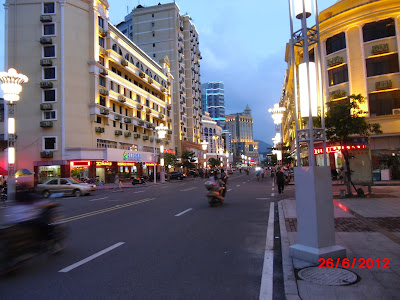














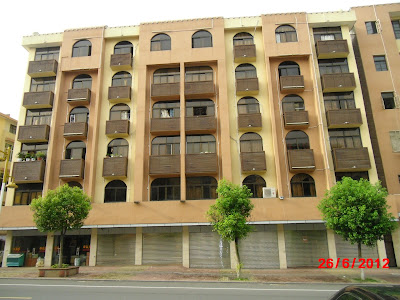












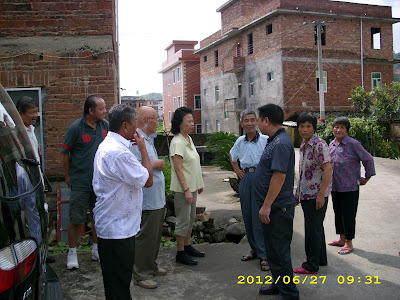


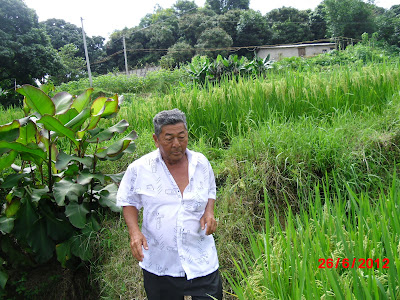








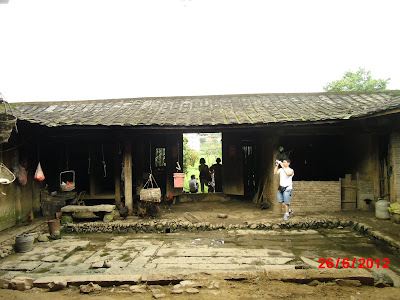





























































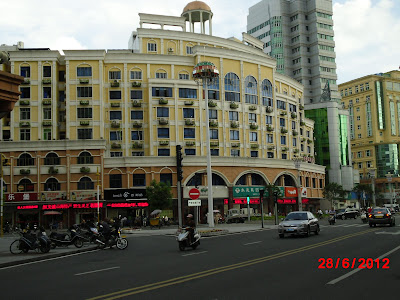




























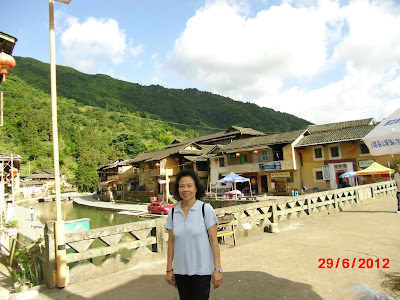




















No comments:
Post a Comment